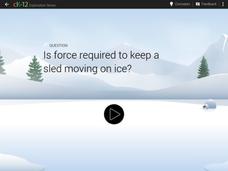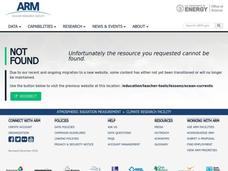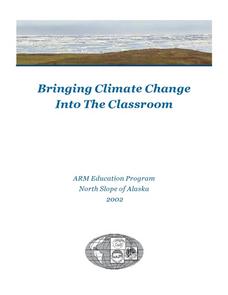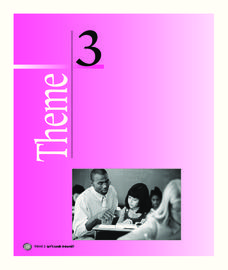Curated OER
Cartoons for the Classroom: Canada Toons out as NHL Ices Season
In this current events instructional activity, students analyze a political cartoon about the 2004-2005 cancelled National Hockey League season. Students then respond to 4 talking point questions.
US Environmental Protection Agency
Getting to the Core: The Link Between Temperature and Carbon Dioxide
Polar ice samples provide scientists with valuable information about the condition of the atmosphere for hundreds of thousands of years in the past. Of particular interest is the amount of carbon dioxide in the atmosphere and its...
Arcademics
Capital Penguin
Hop across the country like a penguin from ice floe to ice floe using an interactive video game. Acting as a penguin, learners match capitals to their states. Game features allow teachers to set up competitions and check learning progress.
CK-12 Foundation
First Law Simulation
Does Newton's First Law of Motion explain how to move a sled across ice? A simulation encourages scholars to decide if they should push, pull, or apply no force. Their decision moves a sled across the ice and to the home at the...
PBS
Reading Adventure Pack: The Snowy Day
Scholars listen to a read-aloud of fiction and nonfiction books, The Snowy Day, written and illustrated by Ezra Jack Keats, and Snow Is Falling, written by Franklyn Branley and illustrated by Holly Keller, then take part in four creative...
Climate Research Facility
Ocean Currents
Young scientists investigate the effects of heating a beaker of ice water by dropping dye into the water and observing how the color circulates.
Curated OER
Bringing Climate Change Into the Classroom
Learners investigate the greenhouse effect and examine the potential effects of climate change in the Arctic. They construct a mini-greenhouse and test its effect on temperature, analyze historical climate statistics, and conduct an...
Curated OER
The World of Amelia Bedelia
Get ready to laugh with your class by reading the book Amelia Bedelia's First Day of School. After they read the book and do activities comparing their first day of school with Amelia' they will then have conversations around the story....
Curated OER
Cookin' Up a Comet
Students view a teacher demonstration of comet composition. In this comet science lesson, students watch as the teacher combines sand, ammonia, cola, and dry ice to simulate the composition of a comet. They answer discussion questions...
Curated OER
Changing Planet: Sea Levels Rising
Begin by showing a six-minute video, Changing Planet: Rising Sea Level as an anticipatory set. Pupils draw a topographic map of a potato continent. Finally, they will visit NOAA's sea levels online map and NASA's carbon dioxide...
Curated OER
Floating and Sinking - An Investigation
A simple and effective presentation could be helpful for your young scientists. Learners consider whether or not a piece of wood, glass, cork, brick, and ice will float or sink when placed in water. After the class has made their...
Curated OER
Neuron Cookie
Find out just how enticing learning about neurons can be by creating models with sugar cookies, icing, and candy. With great background information for you and an easy procedure for the kids, studying cells has never been more fun or...
Scholastic
Study Jams! Tree Diagrams
With so many toppings to chose from, make the ice cream truck combinations a fun math problem that teaches your learners about outcomes. The video introduces a tree diagram that allows your mathematicians to see how to create...
Carnegie Mellon University
Introduction to Climate
Begin a full lesson on climate change by demonstrating how carbon dioxide gas contributes to increased temperatures. Be aware that pressure inside the antacid-containing bottle in Activity 2 may cause the lid to fly off; keep viewers at...
Teacher Printables
Biography Question Page
Break the ice on the first day of school with a fun interview activity. Kids ask each other 12 questions (sample questions are included in the margin), and finish the activity by writing a final biography about their partner.
Mr. Hill's Science Website
Density Workbook
It's all about density! Here's a dense workbook for young scientists; they solve (and show work for) 29 density word problems, including a problem where they solve for the density of Godzilla. They complete labs analyzing metal...
Kindergarten Kindergarten
Living and Non-Living Sort
What do an ice cream cone, bicycle, and alarm clock all have in common? That's exactly what young scientists will find out as sort these pictures and learn about the differences between living and non-living things.
Houghton Mifflin Harcourt
Let’s Look Around!: Challenge Activities (Theme 3)
Let's Look Around! is the theme of a unit that offers a plethora of challenge activities. Enhance your scholars' learning experiences and reinforce concepts with activities such as writing a book about farm animals, an...
Teach Engineering
Earthquakes Living Lab: The Theory of Plate Tectonics
Find out if your class agrees with Ice Age: Continental Drift ... or if it's just a fun family movie! Class members research the theory of continental drift, examine evidence of plate tectonics, connect...
Virginia Department of Education
Molar Heat of Fusion for Water
How can you describe heat of fusion in a way the class understands and relates the importance of this concept to present day issues? In this third lesson of the series, learners conduct an experiment, demonstrating the flow of heat...
Star Wars in the Classroom
Star Wars Geography Unit
What kind of animals live on an ice planet like Hoth? How would the habitat on Tatooine allow different organisms to thrive? Connect social studies, science, and Star Wars in one engaging activity that focuses on the ecosystems...
Polar Trec
Arctic Smorgasbord!
Two blooms of phytoplankton, instead of just one, now occur in the Arctic due to declining sea ice, which will have widespread effects on the marine life and climate. In small groups, participants build an Arctic food web with given...
Normal Community High School
Crystalline Structure
Cubic crystals can have 6, 8, and even 12 sides. Here is a presentation that shows pupils three different kinds of cubic crystalline structures: cubic, body-centered, and face-centered. These structures are then applied to three...
University of Colorado
Using Spectral Data to Explore Saturn and Titan
Saturn's rings are made of dust, ice, and solid chunks of material. Individuals use spectrographs in this final installment of 22 lessons to determine the atmospheric elements. They analyze spectrums from Titan's atmosphere and...
Other popular searches
- Ice Cream
- Ice Age
- Ice Cube Melting Experiment
- Ice Breakers
- Ice Breaker Games
- Ice Hockey
- Dry Ice
- Ice Skating
- Ice Land Volcanoes
- Dry Ice Experiments
- Ice Breaker Activities
- Ice Cream Graph























